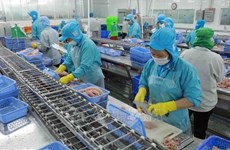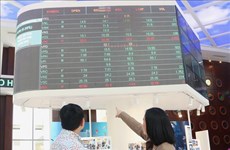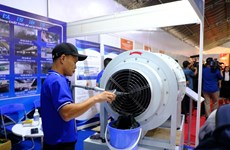Red River Delta targets higher GDP
The Prime Minister has recently approved a master plan on
socio-economic development from now until 2020 in the Red River Delta.
Under the plan, the region’s contribution to national gross domestic product (GDP) is expected to increase from 24.7 percent in 2010 to 26.6 percent in 2015 and 28.7 percent in 2020.
Under the plan, the region’s contribution to national gross domestic product (GDP) is expected to increase from 24.7 percent in 2010 to 26.6 percent in 2015 and 28.7 percent in 2020.
The Prime Minister has recently approved a master plan on
socio-economic development from now until 2020 in the Red River Delta.
Under the plan, the region’s contribution to national gross domestic product (GDP) is expected to increase from 24.7 percent in 2010 to 26.6 percent in 2015 and 28.7 percent in 2020.
Meanwhile, the region’s average per-capita income will climb to 2,500 USD by 2015 and about 4,180 USD by 2020, which is 1.3 times of the national average.
By 2020, the agricultural sector will account for 7-7.5 percent of the region’s GDP, industry and construction, 45-47 percent and services, 46-48 percent.
Priorities will be given to high quality transport, consultation, design, invention, finance-banking, telecommunications, education-training, healthcare, trade, tourism, science and technology.
The services sector targets an annual growth rate of about 10 percent during the 2011-2020 period.
Modern telecom infrastructure and better broadband coverage are also listed in the plan.
By 2020, 80-85 percent of households will have fixed land lines and over 70 percent of the population will have access to the Internet.
With the ambition to develop tourism into a spearhead sector, the region will pour investment into building a number of key tourism areas that satisfy international standards.
In 2015, the region is expected to welcome 17-18 million domestic visitors and 3.2-3.5 million international tourists. The numbers are expected to hit 24-25 million and 4.5-5 million respectively in 2020.
In industry, the Red River Delta will focus on sectors that have a competitive edge, a high rate of locally made contents and capacity to integrate into global value chains such as electronics, information-technology, telecommunications, machinery, ship building, high-quality steel and new construction materials, chemicals, pharmaceuticals, food processing industry, garments-textiles, and footwear.
Garments-textiles and footwear will be developed to serve both international and domestic consumption while more attention will be paid to supporting industries such as thread making, dyeing and design in order to increase the population of locally made contents in manufactured products.
Investors are encouraged to continue investing in industrial parks, especially those repairing and building ships and other marine vehicles in Hai Phong, Quang Ninh and Nam Dinh.
In agriculture, the region will focus on intensive cultivation of rice, vegetables and flowers, pig and poultry farming at an industrial scale and aquaculture using cutting-edge technologies.
Economic and social infrastructure will be developed synchronously to generate momentum for the region’s socio-economic development.
The system of highways connecting the region’s economic, commercial and service centres will be completed during the period.
Under the plan, the Hai Phong and Quang Ninh port cluster is expected to be modernised. Lach Huyen seaport in Hai Phong port city will be turned into an international port.
While upgrading the existing railway system and building elevated railway lines in Hanoi, the region will work on building an express railway network linking Hanoi with Ho Chi Minh City, Lao Cai, Hai Phong and Lang Son.-VNA
Under the plan, the region’s contribution to national gross domestic product (GDP) is expected to increase from 24.7 percent in 2010 to 26.6 percent in 2015 and 28.7 percent in 2020.
Meanwhile, the region’s average per-capita income will climb to 2,500 USD by 2015 and about 4,180 USD by 2020, which is 1.3 times of the national average.
By 2020, the agricultural sector will account for 7-7.5 percent of the region’s GDP, industry and construction, 45-47 percent and services, 46-48 percent.
Priorities will be given to high quality transport, consultation, design, invention, finance-banking, telecommunications, education-training, healthcare, trade, tourism, science and technology.
The services sector targets an annual growth rate of about 10 percent during the 2011-2020 period.
Modern telecom infrastructure and better broadband coverage are also listed in the plan.
By 2020, 80-85 percent of households will have fixed land lines and over 70 percent of the population will have access to the Internet.
With the ambition to develop tourism into a spearhead sector, the region will pour investment into building a number of key tourism areas that satisfy international standards.
In 2015, the region is expected to welcome 17-18 million domestic visitors and 3.2-3.5 million international tourists. The numbers are expected to hit 24-25 million and 4.5-5 million respectively in 2020.
In industry, the Red River Delta will focus on sectors that have a competitive edge, a high rate of locally made contents and capacity to integrate into global value chains such as electronics, information-technology, telecommunications, machinery, ship building, high-quality steel and new construction materials, chemicals, pharmaceuticals, food processing industry, garments-textiles, and footwear.
Garments-textiles and footwear will be developed to serve both international and domestic consumption while more attention will be paid to supporting industries such as thread making, dyeing and design in order to increase the population of locally made contents in manufactured products.
Investors are encouraged to continue investing in industrial parks, especially those repairing and building ships and other marine vehicles in Hai Phong, Quang Ninh and Nam Dinh.
In agriculture, the region will focus on intensive cultivation of rice, vegetables and flowers, pig and poultry farming at an industrial scale and aquaculture using cutting-edge technologies.
Economic and social infrastructure will be developed synchronously to generate momentum for the region’s socio-economic development.
The system of highways connecting the region’s economic, commercial and service centres will be completed during the period.
Under the plan, the Hai Phong and Quang Ninh port cluster is expected to be modernised. Lach Huyen seaport in Hai Phong port city will be turned into an international port.
While upgrading the existing railway system and building elevated railway lines in Hanoi, the region will work on building an express railway network linking Hanoi with Ho Chi Minh City, Lao Cai, Hai Phong and Lang Son.-VNA













